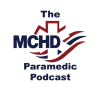We often start with a diagnosis and teach from there – we’ve attempted to flip this script with our initial serial killer series, which included chest pain, shortness of breath and altered mental status. However, we concentrated primarily on medical serial killers during those episodes and, honestly, we didn’t include trauma. So, in this episode, we’re going to discuss the trauma serial killers
When people suffer major trauma – what things can kill them emergently?
- Hemorrhagic shock
- Obstructive shock – Tension PTX/tamponade
- Hypoxemia (high C-spine injury)
- Closed head injury
- DIC
Where to start?
- En route: always approach trauma calls considering the killer 5 diagnoses first
- Vitals are vital (don’t forget the ETCO2/shock index/kids will compensate, beware of trauma plus tachycardia in pediactrics)
- Exam: pupils are overrated! GCS motor is likely more reliable
- Mind your scene time
- To care for trauma patients, we must gain control – respect traumatic thrash
This episode includes:
- Hemorrhage. Think through all the spots blood can hide
- Obstructive shock. Tension PTX and tamponade
- Hypoxemia. BVM, SGA or ETT
- Closed head injury. GCS motor
- DIC. Don’t forget to warm these patients
Take home points
- Always expose and control the patient – we can’s assess things we can’t see and it’s impossible to care for a sick trauma patient while wrestling them
- Less scene time = quicker time to surgeon
- TXA 2g – while en route
- Needle T in the fourth ICS AAL
- Avoid and prevent hypoxia and hypotension in CHI
- Warm your trauma patients
References
- Childress K, et al. Prehospital End-tidal Carbon Dioxide Predicts Mortality in Trauma Patients. Prehosp Emerg Care. 2018 Mar-Apr;22(2):170-174.
- Androski CP Jr, et al. Case Series on 2g Tranexamic Acid Flush From the 75th Ranger Regiment Casualty Database. Journal of Special Operations Medicine : a Peer Reviewed Journal for SOF Medical Professionals. 2020 ;20(4):85-91.
- Taghavi S, et al. An Eastern Association for the Surgery of Trauma multicenter trial examining prehospital procedures in penetrating trauma patients. J Trauma Acute Care Surg. 2021 Jul 1;91(1):130-140.
- Sims CA, et al. Effect of Low-Dose Supplementation of Arginine Vasopressin on Need for Blood Product Transfusions in Patients With Trauma and Hemorrhagic Shock: A Randomized Clinical Trial. JAMA Surg. 2019 Nov 1;154(11):994-1003.
- Kupas DF, et al. Glasgow Coma Scale Motor Component (“Patient Does Not Follow Commands”) Performs Similarly to Total Glasgow Coma Scale in Predicting Severe Injury in Trauma Patients. Ann Emerg Med. 2016 Dec;68(6):744-750.
- Rankin CJ, et al. A review of transfusion- and trauma-induced hypocalcemia: Is it time to change the lethal triad to the lethal diamond? J Trauma Acute Care Surg. 2020 Mar;88(3):434-439.
- Laan DV, et al. Chest wall thickness and decompression failure: A systematic review and meta-analysis comparing anatomic locations in needle thoracostomy. Injury. 2016 Apr;47(4):797-804.













